市场资讯及洞察

Most traders understand EA portfolio balance through the lens of traditional risk management — controlling position sizes, diversifying currency pairs, or limiting exposure per trade.
But in automated trading, balance is about deliberately constructing a portfolio where different strategies complement each other, measuring their collective performance, and actively managing the mix based on those measurements.
The goal is to create a “book” of EAs that can help diversify performance over time, even when individual strategies hit rough patches.
A diversified mix of EAs across timeframes and assets can, in some cases, reduce reliance on any single strategy. This approach reduces dependency on any single EA’s performance, smooths your overall equity curve, and builds resilience across changing market conditions.
It’s about running the right mix, identifying gaps in your coverage, and viewing your automated trading operation as an integrated whole rather than a collection of independent systems.
Basic Evaluation Metrics – Your Start Point
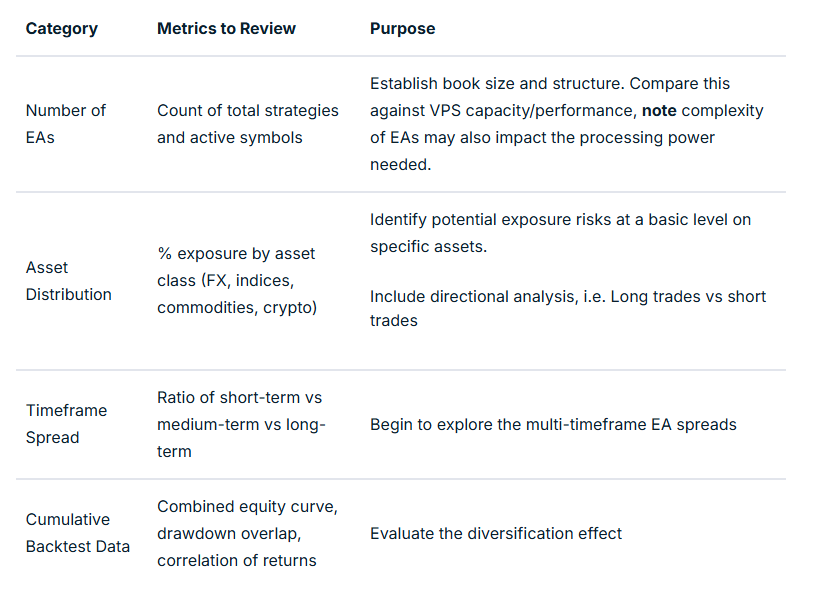
Temporal (timeframe) Balancing
When combined, a timeframe balance (even on the same model and instrument) can help flatten equity swings.
For example, a losing phase in a fast-acting M15 EA can often coincide with a profitable run in an H4 trend model.
Combining this with some market regime and sessional analysis can be beneficial.
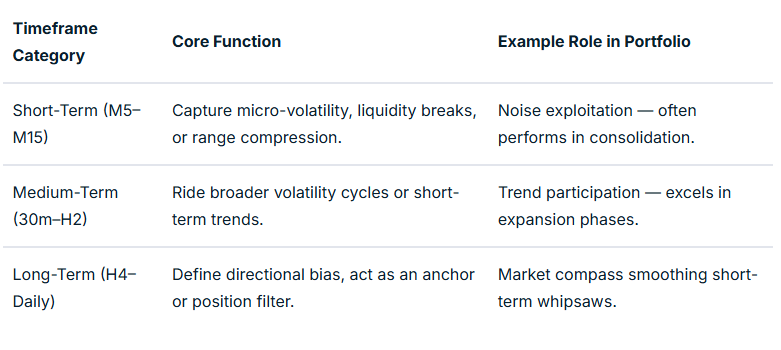
Asset Balance: Managing Systemic Correlation Risk
Running five different EAs on USDJPY might feel diversified if each uses different entry logic, even though they share the same systemic market driver.
But in an EA context, correlation measurement is not necessarily between prices, but between EA returns (equity changes) relating to specific strategies in specific market conditions.
Two EAs on the same symbol might use completely different logic and thus have near-zero correlation.
Conversely, two EAs on a different symbol may feel as though they should offer some balance, but if highly correlated in specific market conditions may not achieve your balancing aim.
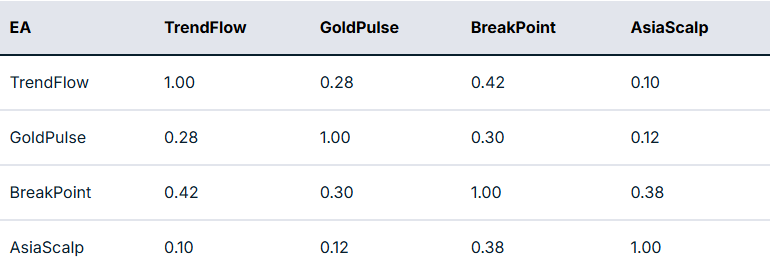
In practical terms, the next step is to take this measurement and map it to potential actionable interventions.
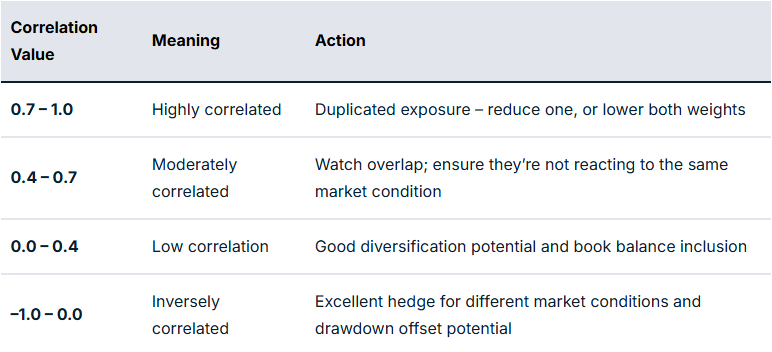
For example, if you have a EURUSD Trend EA and a GBPUSD Breakout EA with a correlation of 0.85, they are behaving like twins in performance related to specific market circumstances. And so you may want to limit exposure to some degree if you are finding that there are many relationships like this.
However, if your gold mean reversion EA correlates 0.25 compared to the rest of your book, this may offer some balance through reducing portfolio drawdown overlap.
Directional and Sentiment Balance
Markets are commonly described as risk-on or risk-off. This bias at any particular time is very likely to impact EA performance, dependent on how well balanced you are to deal with each scenario.
You may have heard the old market cliché of “up the staircase and down the elevator shaft” to describe how prices may move in alternative directions. It does appear that optimisation for each direction, rather than EAs that trade long and short, may offer better outcomes as two separate EAs rather than one catch-all.
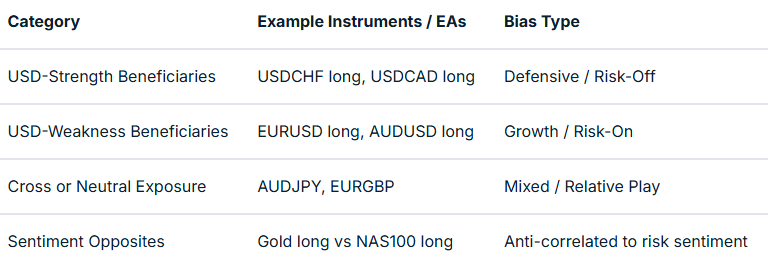
Market Regime and Volatility Balance
Trend and volatility states can have a profound impact on price action, whether as part of a discretionary or EA trading system. Much of this has a direct relationship to time of day, including the nature of individual sessions.
We have a market regime filter that incorporates trend and volatility factors in many EAs to account for this. This can be mapped and tested on a backtest and in a live environment to give evidence of strategy suitability for specific market conditions.
For example, mean reversion strategies may work well in the Asian session but less so in strongly trending markets and the higher volatility of the early part of the US session.
As part of balancing, you are asking questions as to whether you actually have EA strategies suited to different market regimes in place, or are you using these together to optimise book performance?
The table below summarises such an approach of regime vs market mapping:
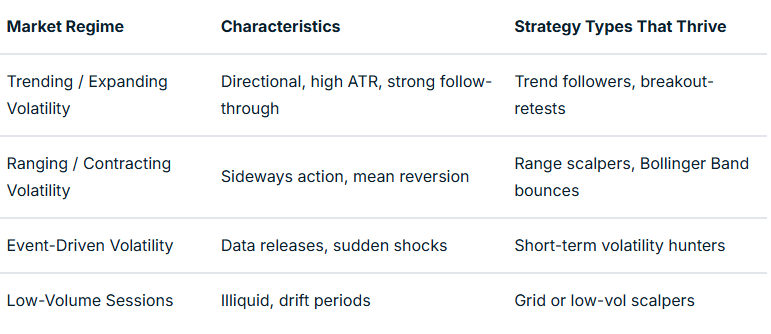
Multi-Level Analysis: From Composition to Interaction
Once your book is structured, the challenge is to turn it into something workable. An additional layer of refinement that turns theory and measurement into something meaningful in action is where any difference will be made.
This “closing the circle” is based on evidence and a true understanding of how your EAs are behaving together. It is the step that takes you to the point where automation can begin to move to the next level.
Mapping relationships with robust and detailed performance evaluation will take time to provide evidence that these are actually making a difference in meeting balancing aims.
To really excel, you should have systems in place that allow ongoing evaluation of the approaches you are using and advise of refinements that may improve things over time.
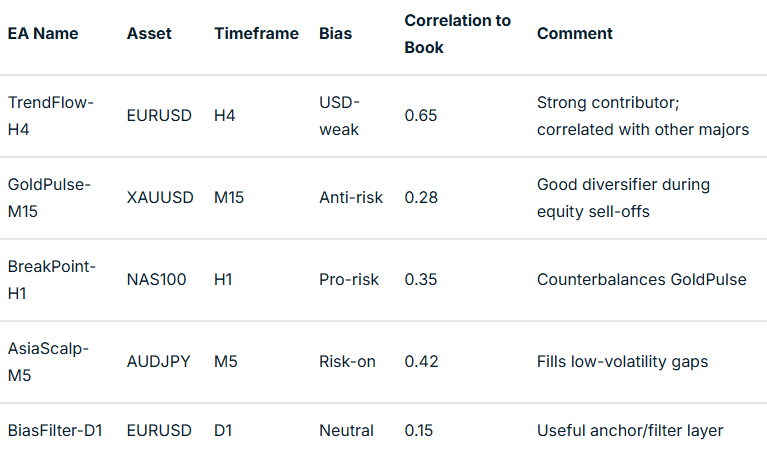
What Next? – Implementing Balance in Practice
Theory must ultimately translate into an executable EA book. A plan of action with landmarks to show progress and maintain motivation is crucial in this approach.
Defining classification tags, setting risk weights, and building monitoring dashboards are all worth consideration.
Advanced EA traders could also consider a supervisory ‘Sentinel’ EA, or ‘mothership’ approach, to enable or disable EAs dynamically based on underlying market metrics and external information integrated into EA coding decision-making.
Final Thoughts
A balanced EA portfolio is not generated by accident; it is well-thought-out, evidence-based and a continuously developing architecture. It is designed to offer improved risk management across your EA portfolio and improved trading outcomes.
Your process begins with mapping your existing strategies by number, asset, and timeframe, then expands into analysing correlations, directional bias, and volatility regimes.
When you reach the stage where one EA’s drawdown is another’s opportunity, you are no longer simply trading models but managing a system of EA systems. To finish, ask yourself the question, “Could this approach contribute to improved outcomes over time?”. If your answer is “yes,” then your mission is clear.
If you are interested in learning more about adding EAs to your trading toolbox, join the new GO EA Programme (coming soon) by contacting [email protected].


2025年6月的法兰克福,欧洲央行第八次按下降息按钮。当25个基点的利率削减落地时,市场却见证了一场反直觉的货币表演:欧元兑美元应声跳涨至1.092,创下年内新高。这场持续一年的降息马拉松已累计释放200基点流动性,欧元却较年初升值2.5%。传统货币平价理论似乎失了效,一场关于汇率定价权的重构正在上演。
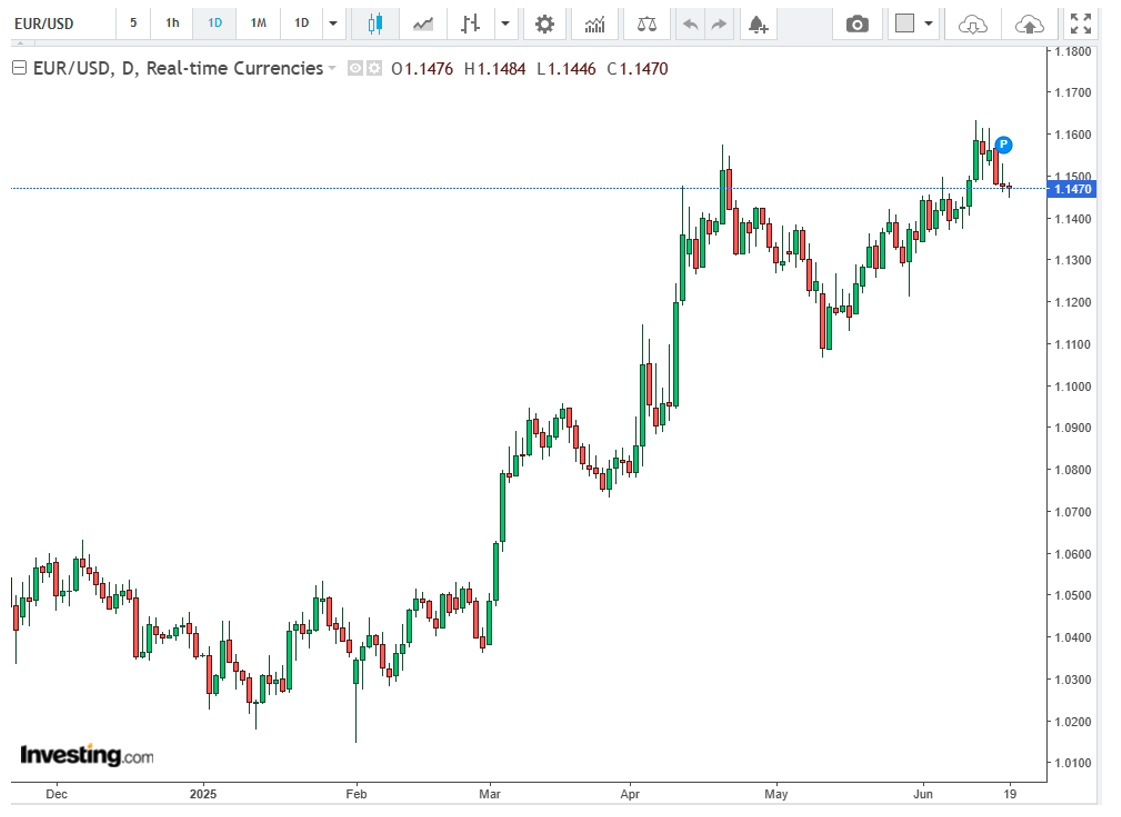
1. 政策预期差是欧元反弹的核心引擎降息周期尾声的明确信号成为关键转折点。欧洲央行行长拉加德在6月会议后的声明中埋下伏笔:"在当前的利率路径下,我们处于有利位置。"路透社曝光的内部讨论进一步佐证——决策层已达成共识,暂停降息至少维持至9月。这一转向的底气来自最新通胀数据:(1) 6月核心HICP环比降至0.2%(前值0.6%)(2) 2025年通胀预测下调至2.0%(去年12月预测2.3%)(3) 但服务通胀仍顽固保持在3.9%
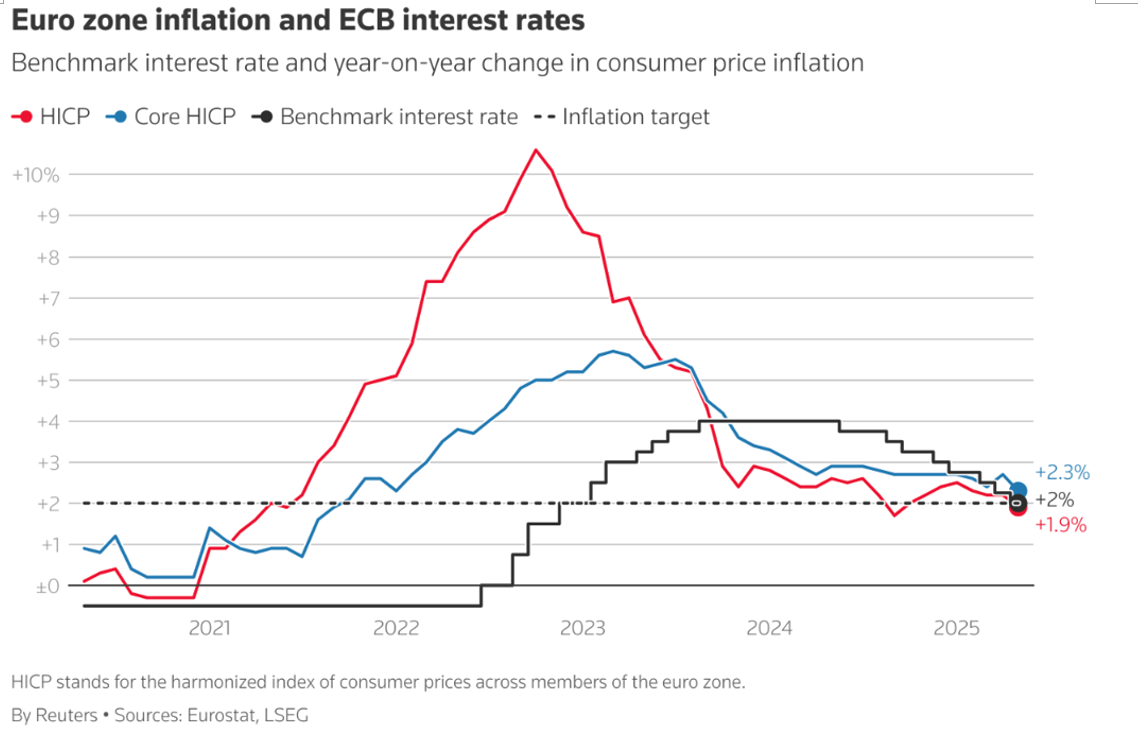
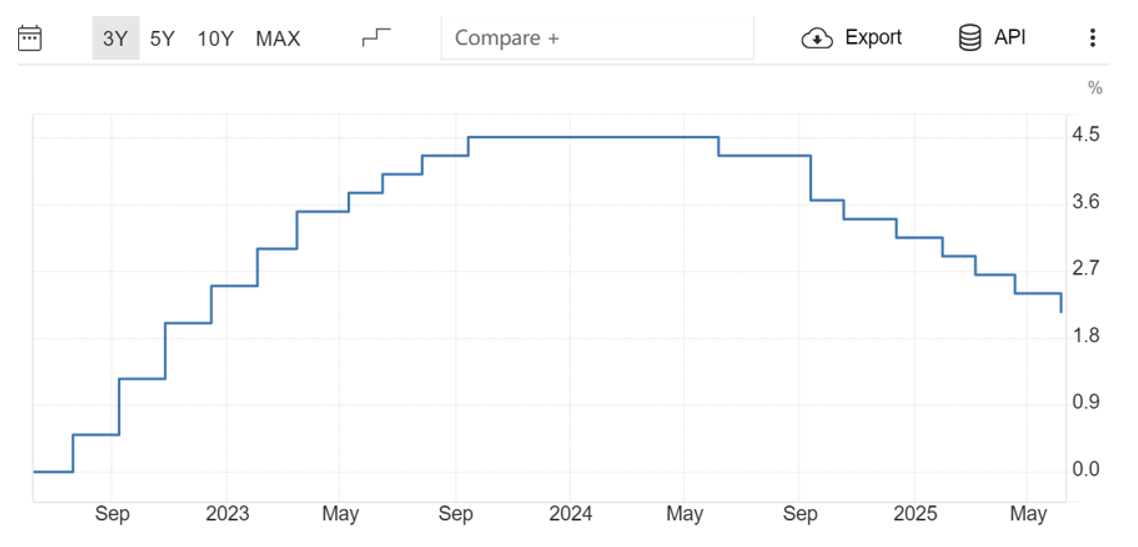
(图:欧元区通胀与利率走势图显示,2025年6月降息后利率曲线趋平)与此同时,美联储的降息时钟正在滴答作响。CME FedWatch Tool显示,9月降息概率达58.4%。当欧洲央行率先完成宽松周期而美联储刚刚启动时,政策节奏差取代绝对利差成为新主导因素。2. 美元的双重困局:当债务撞上政治放任美元指数的持续疲软揭露出更深层变革。美元指数在2025年6月跌破100关口,较年初下跌4.7%,背后是三股力量的合谋:(1) 债务雪球加速滚动美国财政部2025年第一季度债务展期规模达1.2万亿美元,偿债成本占GDP比例突破3.5%历史阈值。当10年期美债收益率维持在4.3%高位,每加息1%意味着年度利息支出增加3000亿美元。(2) 政治放任助推贬值
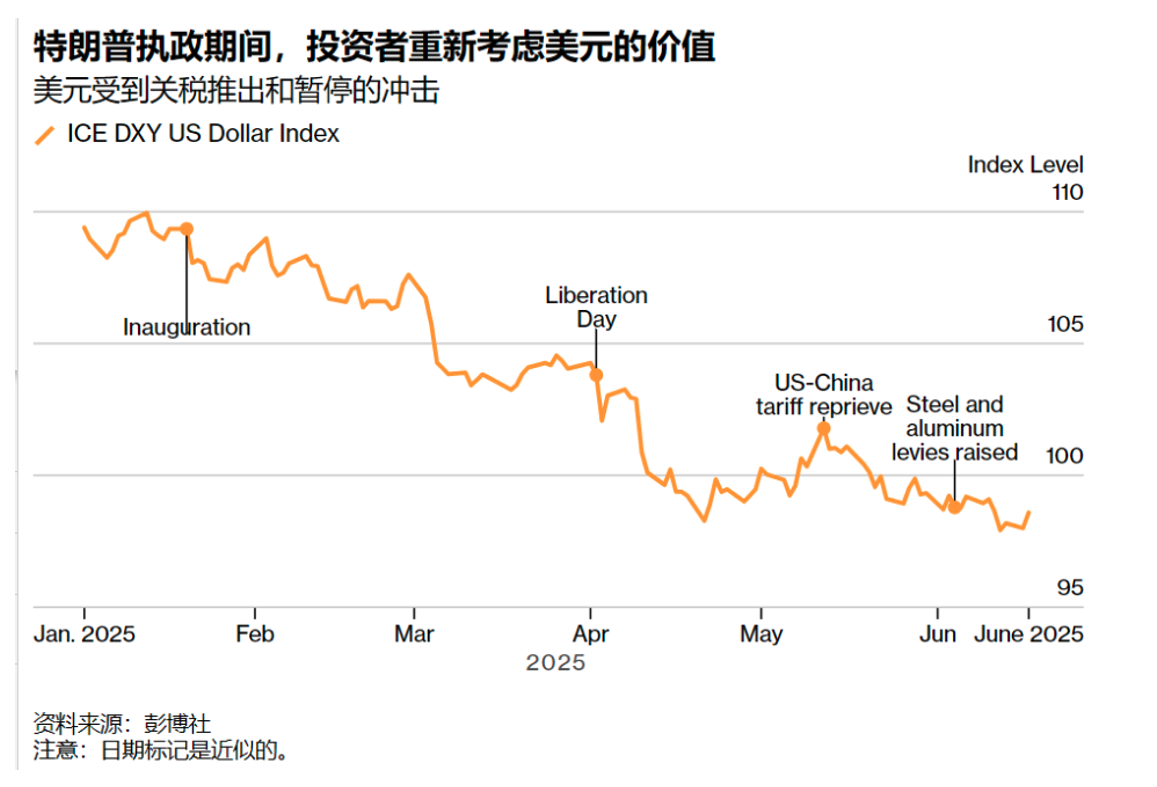
• 3月"解放日"事件:特朗普解除伊朗石油制裁引发美元单日暴跌1.8%• 5月钢铁关税重启:针对亚洲国家的金属关税冲击贸易信心• 6月台币闪崩:美元兑台币1小时暴跌4%,暴露汇率武器化风险(3) 空头大军压境
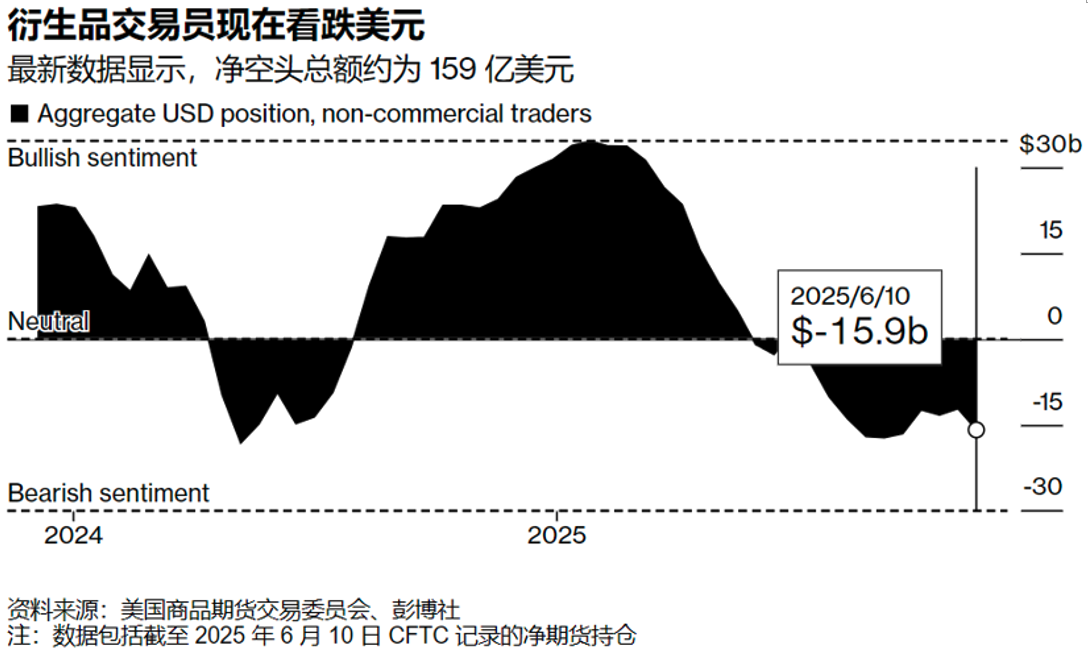
• 对冲基金美元净空头达159亿美元(6月10日数据)• 美银调查:全球基金经理减持美元比例创20年新高"特朗普团队对美元暴跌的漠视令人震惊",前美联储经济学家萨拉·张分析说,"当台币闪崩事件后,财政部仅用模板化声明敷衍,这等于默许贬值。"(4) 欧元的风险天花板尽管技术面突破1.0850关键位,但欧元上行面临三重压制:• Politics黑天鹅:法国极右翼支持率升至35%,OAT-Bund利差攀升至148基点• 能源命门:乌克兰输气管道遇袭,TTF天然气期货单周暴涨22%• 经济底色:欧元区5月制造业PMI仍处收缩区间(48.1)3. 历史转折点的生存法则当前格局与2017年特朗普税改时期形成镜像对照:"当偿债成本吞噬军费预算时,强美元已成奢侈品,"高盛货币策略师汤姆森指出,"财政部最新2400亿美元发债计划流标率创9年新高,这就是市场用脚投票的证明。"由此演变出来的新货币丛林法则——"汇率已成政治筹码,债务天花板决定货币天花板"4. 未来三个月关键节点:(1) 7月15日:特朗普政府2000亿美元对华关税最终决定(2) 8月7日:美国十年期国债拍卖(检验承接能力)(3) 9月5日:欧央行利率决议(暂停承诺验证)此刻的欧元强势,本质是货币政策青黄不接期的喘息。当美联储真正开启降息闸门,美元或因"失血缓解"获得短暂支撑,但决定长期走向的,将是美国能否在122%的债务深渊边找到财政平衡支点。联系方式:墨尔本 03 8658 0603悉尼 02 9188 0418中国地区(中文) 400 120 8537中国地区(英文) +248 4 671 903作者:Christine Li | GO Markets 墨尔本中文部


本周市场在多重不确定性下展现出韧性。面对地缘紧张加剧及关税谈判临近节点,美股依然维持相对稳健,美联储的鸽派基调也为市场情绪提供了支撑。✳️ 美联储按兵不动,降息预期升温北京时间今晨,美联储如预期维持基准利率不变。主席鲍威尔在会后发言中释放出相对温和的信号,市场对年内降息的期待升温,预计仍有望看到两次降息。尽管地缘因素尚未明朗,鸽派措辞令市场暂时松了口气。与此同时,美国政策层面释放出“灵活但审慎”的态度。市场解读为:即使通胀波动仍在,美联储也不会轻易收紧政策,为未来应对潜在风险保留空间。 全球局势紧张,能源与避险资产受关注中东紧张局势再度升级,相关消息虽未最终定论,但投资者开始调整风险敞口。黄金小幅上涨,目前仍徘徊在每盎司3380美元下方;原油价格维持高位,避险情绪虽有所抬升,但波动控制在合理区间内。恐慌指数小幅上行,汇市表现相对平稳。美元指数仍坚守98关口,为六月以来的重要技术支撑位。澳元兑美元维持在0.65一线震荡,日元与人民币兑美元则分别围绕145和7.19波动。 板块聚焦:稳定币、核电及科技股领涨个股方面,Coinbase 宣布将 USDC 纳入抵押资产用于期货交易,这一举措推动稳定币概念再掀高潮。Circle(CRCL)股价单日暴涨超30%,提前实现本周200美元目标,Coinbase 亦同步上涨逾18%。值得一提的是,知名机构投资者 Ark Invest 本周大幅减持 CRCL 和 Meta,同时加仓核电龙头 BWXT,再次成为市场情绪的风向标。核电主题再度活跃,受铀价格持续走高影响,澳洲相关个股今日有望跟随上涨。BWXT 与 OKLO、SMR、NNE 并列美股四大核能成长股,未来潜力仍被市场看好。比特币方面,价格变动不大,整体维持在高位盘整阶段。 总结市场当前在多重因素博弈下维持韧性运行。美联储释放鸽派信号、稳定币创新助推数字资产走强,而中东局势及能源价格仍是短线关注焦点。投资者可密切留意本周剩余经济数据及美股技术走势,在波动中寻找结构性机会。如需针对某板块进行进一步深度分析,欢迎留言或私信,我们将为您定制解读。免责声明:GO Markets 分析师或外部发言人提供的信息基于其独立分析或个人经验。所表达的观点或交易风格仅代表其个人;并不代表 GO Markets 的观点或立场。联系方式:墨尔本 03 8658 0603悉尼 02 9188 0418中国地区(中文) 400 120 8537中国地区(英文) +248 4 671 903作者:Xavier Zhang | GO Markets 高级分析师
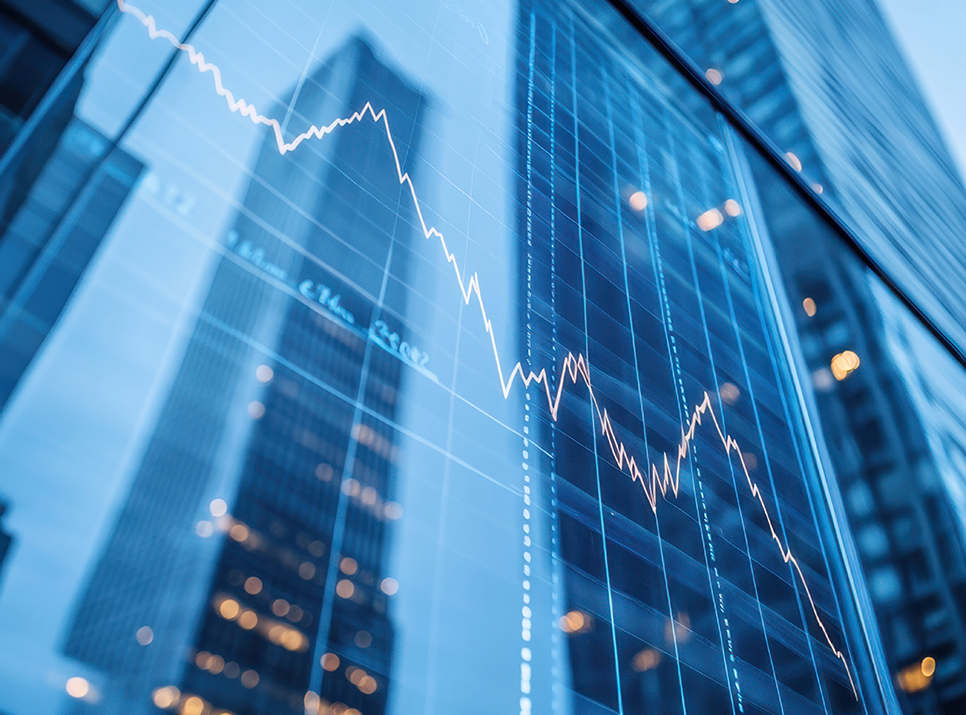

Ignoring corporate actions is a common pitfall many CFD traders fall into. Longing or shorting the underlying share is rooted in technical and fundamental analysis, and simple dividend payouts or buybacks feel unimportant to the trading strategy.However, even though you’re trading an instrument whose value is determined by the movement of an underlying asset, rather than the asset itself, these events can still impact your account balance.It is vital to stay informed of the corporate actions of the underlying share and have a plan for the way you position trades and the length of time you consider holding a position.
Company Dividends
A dividend is the distribution of a portion of a company’s profits to its shareholders. It’s one of the primary ways companies reward investors and signals that the company is in good financial health.
Why Companies Do It:
- To share profits with investors
- To signal stability or maturity
- To attract dividend-focused shareholders
Example:
Woolworths declares a $1 dividend. If you’re long 100 CFDs, you get a $100 credit. If short, you lose $100 on the ex-div date.
CFD Implications:
Long Position: You receive a credit into your account on the ex-dividend date Short Position: Your account is debited the equivalent value.
Market Reaction:
Share prices typically drop by the dividend amount on the ex-div date on open.
Stock Splits and Reverse Splits
A stock split increases the number of shares and reduces the price per share, retaining the existing total market value e.g., your shares may become half the price but you will have double the holding. A reverse split (or consolidation) does the opposite so reducing the number of shares so increasing the price per share.
Why Companies Do It:
- Stock splits make high-priced shares more affordable and attractive to retail investors and increase day-to-day interest.
- Reverse splits are less common but may often be used to lift a stock’s price to improve the perceived positive image of the company.
Example:
Tesla executed a 5-for-1 split in 2020. Holding 100 CFDs became 500 CFDs at 1/5th the original price.
CFD Implications:
Your CFD position is automatically adjusted to reflect the new ratio. Total value remains unchanged.
Market Reaction:
Splits can signal growth confidence and attract traders, often leading to short-term rallies. Reverse splits may be seen as a red flag and lead to selling pressure.
Rights Issue
A rights issue allows current shareholders to buy extra shares, usually at a discount to current share price to raise capital. Market response to a right issue will be dependent on the reason for this action and the overall perception as to whether it will benefit the company in the longer term.
Why Companies Do It:
- To fund growth projects, reduce debt, or raise liquidity
- A sign the company is facing financing pressure
Example:
Qantas may offer a 1-for-5 rights issue at a 20% discount to raise capital to enable the company to buy new aircraft. CFD holders do not get this entitlement.
CFD Implications:
You do not receive rights or participate in the offer. No direct adjustment is made to your CFD position.
Market Reaction:
May result in a price drop due to dilution. However, if the capital raise strengthens the company, prices may recover over time.
Share Buybacks
A company buys back its own shares from the market, reducing the total number in circulation.
Why Companies Do It:
- To return value to shareholders
- To improve metrics like earnings per share (EPS)
- To signal that management believes the stock is undervalued
Example:
BHP announces a $2 billion buyback. As shares are repurchased, the price may gradually rise due to the reduced supply of shares available to trade on the market.
CFD Implications:
There is no action on any CFD holding in the relevant company, so there is no account adjustment.
Market Reaction:
Often seen as mildly bullish, especially for undervalued companies. However, buybacks funded by debt may raise concerns.
Mergers and Acquisitions (M&A)
A merger or acquisition occurs when one company absorbs or combines with another. This may ultimately lead to a change in share structure or ticker symbol if it is approved by the shareholders of the company. There is often a situation where a proposal is presented to the company that results in an elevated share price even before any decision is made.
Why Companies Do It:
- To expand market share, gain assets, or eliminate competition
- Often part of a strategic growth plan
Example:
If Company A merges with Company B and issues 1 new share for every 2 held, your 200 CFDs in A would convert into 100 CFDs in the new entity.
CFD Implications:
Your existing CFD position is converted into the new merged entity (if applicable) using the agreed share ratio.
Market Reaction:
Target companies often rally when takeover bids emerge, while acquirers may see mixed reactions — depending on perceived value or cost of the deal.
Trading Halts
A pause in trading that is imposed by the exchange usually often due to a pending news release from the company about a new, unexpected corporate action or less commonly some regulatory concerns pending investigation.
Why Companies May Be Halted:
- Awaiting a price-sensitive announcement
- Pending merger, legal issue, or earnings release
Example:
If a US biotech stock CFD is halted for an FDA ruling, you’ll remain in your position until the underlying reopens.
CFD Implications:
If the stock is halted, your CFD is also paused. You cannot open or close positions until trading resumes (there will often be a second release informing when the stock is likely to reopen for trading).
Market Reaction:
Trading halts usually precede large price moves — often gaps and reopens — so significant gains or losses may be the result.
Summary
Just because you’re trading Share CFDs doesn’t mean you are insulated from corporate actions. In fact, understanding their timing (although many are unpredictable) and the possible impact of your holding is essential for planning trades and managing actual and potential account value adjustments.It is prudent to have access to an economic calendar as part of your routine and ensure you check out earnings and ex-dividend dates of any stock CFD you hold or are considering for an entry.Whether it’s a dividend or a major structural event like a merger, these changes can and will shift market sentiment towards the underlying stock. Make sure you stay aware of what is happening and what might happen next. The GO Market support team will always be there to assist with any questions you have before or after any corporate action.


实用派对
在金融市场中,技术分析工具的选择往往能直接影响交易决策的质量。对于大多数交易者而言,TradingView是一款功能强大且易于上手的平台。无论你是刚刚入门的新手,还是经验丰富的资深交易者,TradingView都能提供各种丰富的工具和资源,帮助你实现更精准的市场分析与决策。
TradingView是一个集成了图表、社区、策略测试、市场信息等功能的综合性平台,已成为全球许多投资者和交易者的首选。通过TradingView,用户不仅可以实时查看全球市场的走势,还可以通过其强大的图表分析工具,发现潜在的交易机会。此外,平台上还汇聚了大量的交易者与分析师,用户可以分享和获取交易观点与策略,提升自己的交易水平。
值得一提的是,我们GO Markets券商已于近日上线TradingView,后续用户将可以直接通过我们的平台下单进行交易。这一新功能的上线,将使得 TradingView用户能够在同一平台上完成从市场分析到交易执行的整个流程,大大提高了交易的便利性与效率。未来,TradingView将不仅是你的分析工具,还是你交易的一个重要阵地。
接下来,我们将详细介绍TradingView的主要栏目及其特色功能,帮助你全面了解如何最大化利用这个平台,提升你的交易体验。
首先,注册一个免费的账户后,我们进入 TradingView的官方网站首页。

在页面顶部的导航栏中,主要分为五个子栏目,分别是:Product(产品)、Community(社区)、Markets(市场)、Brokers(券商) 和 More(更多)。
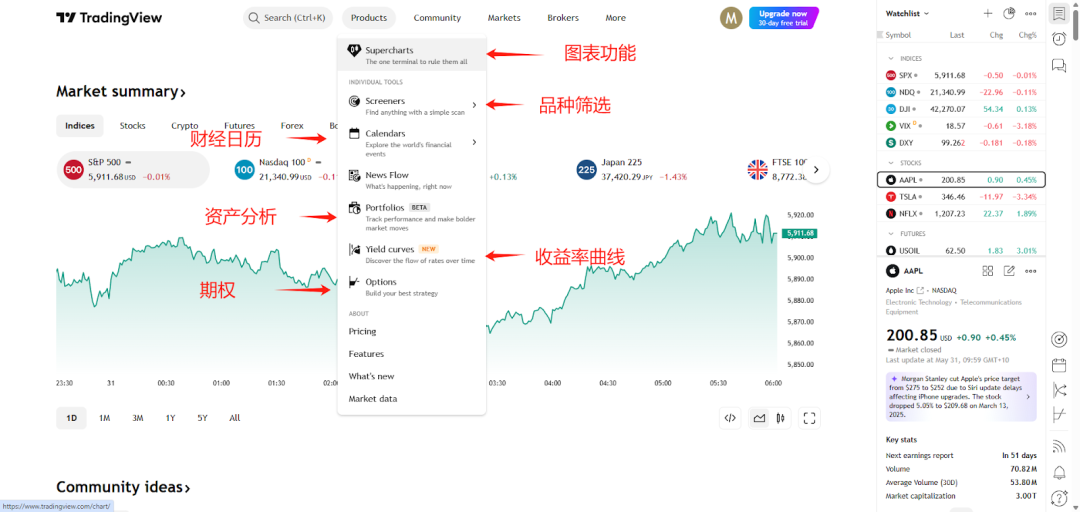
其中,Product 是 TradingView的核心板块,涵盖了多个主要功能:
Supercharts:TradingView最具代表性的图表工具,功能强大,是用户进行技术分析的首选。
Screeners:品种筛选器,支持通过基本面指标、技术指标等条件筛选出符合策略的资产,如股票、外汇或加密货币等。
Calendars(财经日历):用于查看重要经济数据、事件的发布时间,帮助用户掌握宏观面动态。
Portfolio(资产组合分析):可用于管理和分析个人持仓表现,评估整体投资组合。
Yield Curves(收益率曲线):提供各国国债收益率曲线的可视化展示,是分析宏观经济趋势的重要工具。
Options(期权分析):用于查看不同期权策略的风险和收益曲线,辅助制定期权交易策略。
其余四个栏目功能如下:
Community(社区):类似一个交易论坛,用户可以在这里浏览他人的交易观点、策略分享和技术分析,也可以发布自己的内容,与全球交易者互动交流。
Markets(市场):提供全球各类资产的信息,包括股票、外汇、加密货币、指数、期货等。用户可以按国家或资产类别进行筛选,快速查找目标市场的详细行情数据。
Brokers(券商):展示与 TradingView 合作的券商信息。用户可以直接在平台上登录自己的交易账户,并通过 TradingView 图表界面实现下单操作,实现分析与交易的一体化。
More(更多):包含其他实用功能和资源,例如帮助中心、定价方案、移动端应用下载等,便于用户深入了解平台服务或获取支持。
当我们打开TradingView的Supercharts功能后,会进入一个全新的图表页面。页面中央显示的是历史价格走势图,支持多种展示形式,如蜡烛图(K线图)或折线图,用户可通过上方工具栏轻松切换。
在顶部工具栏中,还可以选择图表的时间周期,例如日线、小时线、分钟线等,满足不同交易风格的需求。图表左上方的搜索栏可用于输入代码或名称,快速查找并加载所需的交易品种。
图表左侧是功能丰富的工具栏,提供画线、标注、形态工具等,便于进行技术分析与图表标记。
而在图表下方,则可以快速切换图表的时间范围,例如查看日内走势、过去半年、一年或更长时间的价格变动,帮助用户从不同维度把握市场趋势。
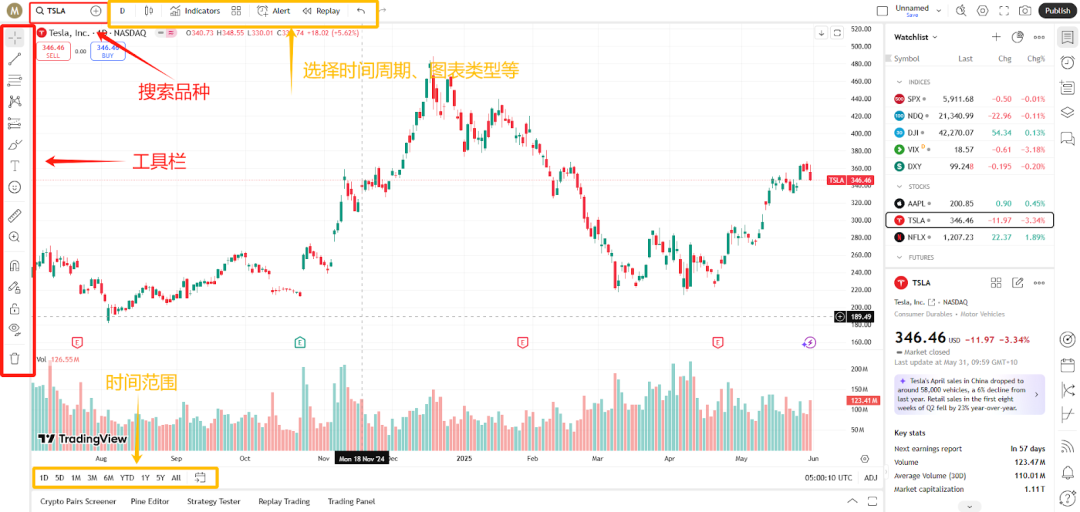
作为全球领先的图表分析平台,TradingView凭借其强大的功能、清晰的界面以及活跃的社区,已经成为广大交易者不可或缺的工具之一。无论是用于日常的技术分析、查看市场行情,还是借助社区获取交易灵感,TradingView都能提供全面而便捷的支持。
更值得期待的是,随着 GO Markets知名券商的接入,用户未来将能够直接在 TradingView平台上完成交易,从而实现“分析 + 下单”一体化的交易体验,大幅提升效率与操作流畅度。
如果你还没有开始使用 TradingView,不妨注册一个免费账户,亲自体验它带来的高效与专业。随着熟练度的提升,相信你也会将它视为日常交易中最得力的助手之一。
免责声明:GO Markets 分析师或外部发言人提供的信息基于其独立分析或个人经验。所表达的观点或交易风格仅代表其个人;并不代表 GO Markets 的观点或立场。联系方式:墨尔本 03 8658 0603悉尼 02 9188 0418中国地区(中文) 400 120 8537中国地区(英文) +248 4 671 903作者:Michael Miao | GO Markets 悉尼中文部


Oil has been thrust back into the spotlight as the negative catalyst for markets. The events over the weekend highlight just how fragile the Middle East is and how it will shape global trading in the second half of 2025.Putting Iran in an oil-specific perspective, despite rising geopolitical tensions, the potential for sustained disruptions to energy supply appears limited for now. This is backed by historical data seen in April, June, and October last year, where heightened risk didn't translate into prolonged price surges.There are absolutely geopolitical concerns around Iranian retaliation, coupled with Israeli retaliation, and so on. But the likelihood of strikes on regional energy infrastructure appears low.Iran’s relationships with Gulf nations have improved markedly, reducing the risk of hostile action toward their oil operations. This has been led by Saudi Arabia, which will be strong in ensuring no disruption to global oil supplies. The caveat is if Iran decides to go at it alone and block the Strait of Hormuz, which would severely impact the likes of Bahrain, Qatar, the UAE, Kuwait, and Iraq. This appears unlikely, but a risk we need to be aware of.
Where does diplomacy sit?
Expectations are for tensions to spike in the short term. However, that will likely lead to renewed diplomatic engagement, particularly if the alternatives prove economically or strategically untenable (i.e., long-term war, regime changes, civil unrest). That's the long term; the near-term resolution is the concern. The United States and the greater regions of Europe and Asia will be brought in. We know that the President has a very high preference for low oil prices as a major part of his election campaign. With no signs, demand is likely to collapse. The only way to keep prices down on this escalation is to ramp up supply. The catch is that US producers remain very reluctant to ramp up supply at current prices. OPEC and Saudi Arabia have already moved to increase production to stamp out non-OPEC members on price, and Russia is still a global pariah with its war with Ukraine. So the supply lever is going to be tricky.
So, what about pricing?
Energy price volatility is being closely tied to positioning in the futures market. Historical patterns show a strong correlation between net longs and Brent pricing.If we speculate that short positions were to be fully unwound (from 187k lots to zero), the implied move could be around $14 per barrel. Brent recently hit $65 per barrel before the conflict and spiked to an intraday high of $78.5 per barrel on the news breaking. This reflects the type of technical squeezes we can expect. Sustained gains would then require fresh long positioning.
Summary
The market remains focused on how Iran and Israel might respond further, and whether any escalation might target energy infrastructure directly. Meanwhile, the U.S. continues to signal interest in keeping diplomatic channels open. Unless Iran decides to go against all expectations and independently block the Strait of Hormuz, we can expect heightened volatility in the short term, without any prolonged surge — similar to the patterns we saw during heightened tensions throughout last year.


Last week, the simmering geopolitical situation in the Middle East took a dramatic turn with Israel launching large-scale airstrikes on Iran. Primarily targeting nuclear and missile sites and key Iranian leaders, fears are increasing of a move towards Iran developing local nuclear development capability.. In the days since, Iran has retaliated with missile and drone strikes on Israeli cities, with continuing attacks in both directions further prompting fears of a wider conflict that could disrupt vital energy routes and drag global powers deeper into a standoff.Markets have already responded to the conflict. We’ve seen concerns over the supply of oil, a pull-back in equities that were within 2% of record highs, and a large shift towards “flight to safety” assets. For traders, this situation adds yet another challenge to the recent high-volatility conditions they have been facing. It further necessitates adherence to a robust, flexible approach to take advantage of opportunities whilst managing the risks of any fast-moving, headline-driven situation. Of course, the situation can turn on a dime both in ferocity and market impact, so this “snapshot” article should be taken as such — it cannot be stressed enough that keeping an eye on the latest developments will be critical in the coming days.
What’s Happening: The Escalation So Far
In just a few days, the situation has moved from a first-phase targeted operation to a broader and predictable conflict:14/06: Israeli strikes disabled major parts of Iran’s Natanz nuclear facility. Satellite images and local reports show extensive structural damage and large power grid failures. There are discussions about the effectiveness of the current Israeli missile capabilities to get “deeper” and create permanent damage. The potential for US assistance in supplying such a “bunker buster” has been discussed.15/06: Iran’s response was significant and immediate, with more than 150 ballistic missiles and over 100 drones launched at strategic targets throughout Israel. Tel Aviv, Haifa, and key military sites have been hit. Although Israel’s advanced missile defence systems intercepted the majority of the attack, some ballistic missiles have caused damage and both civilian and military casualties.Today: Further Israeli strikes are now in progress — a promise made from the very start by the Israeli prime minister. Intelligence and media reports suggest significant further escalation will come within the next few days from both sides.
The Global Response
The United States attempted to immediately distance itself from direct involvement in the initial strikes, although they are seen by many in the Middle East as being indirectly involved through the continued provision of military assets to Israel. The US has reinforced military assets in the Gulf as a potential deterrent. It has also warned Iran against targeting American forces or bases in the region.European leaders, including France’s President Macron and Germany’s Chancellor Scholz, have called for an immediate ceasefire and offered to assist in talks that may produce some resolution. Other oil-producing Gulf States, like Saudi Arabia and the UAE, have publicly urged that both sides exercise restraint. Increased security around their own key oil terminals has been put in place. China and Russia have both issued statements condemning the military escalation, but have largely been passive outside of these comments. Global energy agencies and OPEC+ have not announced any emergency production increases yet on top of what has already been planned. Some contingency planning will be underway in case Hormuz traffic faces disruption.
How Markets Are Positioning Right Now
Oil Supply Risk Creates Significant Moves
Both WTI and Brent crude were seeing a strong last month, but price moves have (not surprisingly) accelerated over the last few days, with both now sitting above $75. The risk is physical supply cuts as well as logistical bottlenecks if ships need naval escorts or higher insurance to pass through Hormuz.
Equities Showing Caution
Global indices are down 1–2% from last week’s levels, after eyeing record highs earlier in the week. There appears to be some rotation out of cyclical and travel stocks, with airline stocks dropping sharply due to the potential for rising jet fuel costs and the need to re-route flights away from the affected region. On the other hand, stocks in the defence and energy sectors have benefited, e.g., Lockheed Martin.
Flight to Safety?
Gold has been the major beneficiary — Gold Futures have pushed over 3400 with a record high less than 0.5% away. Both institutional hedging and retail safe-haven flows are evident, while base metals have dropped with a risk-off rotation.The US Dollar index futures are surprisingly weak, continuing a decline, but risk currencies like the Aussie dollar are showing some weakness against most crosses.US Treasury yields have also dropped modestly through the week.
Five Things to Watch Now
It is relatively early days in this conflict, and how it evolves will determine whether this is a short-lived geopolitical spike or a sustained macro theme that will impact markets on an ongoing basis. There are a few key watchpoints:
- Strait of Hormuz traffic and shipping costs
If insurers price routes significantly higher, or military convoys are needed, oil can spike further, even if there are no direct physical attacks on tankers.
- Prolonged follow-up and “wider” strikes
Continued Israeli raids and Iranian retaliation, and involvement of regional oil infrastructure (like Saudi or UAE pipelines) would be major escalation triggers on oil prices.
- OPEC and emergency output decisions
So far, the major energy organisations have been quiet. Prolonged conflict will force decisions and announcements to be made, with perhaps further increases in oil production.
- Central Bank Rate Impact
Watch Fed, ECB, or RBA statements for clues on whether there may be perceived additional oil-driven inflation risks that may push back any rate cut timeline expectations. The Fed is not expected to offer a likely cut until September, but the RBA is expected to cut at their next meeting
- Volatility
The volatility that markets have experienced this year is likely to continue if any conflict is prolonged and/or escalates. As always, markets struggle with uncertainty and with threats to global growth already on market minds, an increased sensitivity to any news events may be likely.
How to Adapt: System, Entry & Exit Tweaks
In tense geopolitical markets, some trading strategies may need adjusting. It may not be a market that is forgiving for traders caught up in every small headline or succumb to any greed-based actions.Be more selective: Use stronger confirmation before entering breakouts or reversals. e.g., wait for a second bar close above a key level rather than a single spiking candle.Look for confluence: Combine price action with volume increases and confirmation candles to reduce the potential whipsaw risk.Increase use of partial closes: Taking profit on half a position when a logical target is hit could be a tactic worth consideration, trail the rest with a tighter stop.ATR-based trailing stops: Another consideration is to adapt to wider intraday ranges that will be typical in many asset classes.Reduce position size per trade: Lowering tolerable risk levels, especially on leveraged trading instruments, perhaps to 1% risk or below on single trades.Consider more instruments: Use more instruments with a lower correlation to “either way” significant oil price shocks. e.g., lessen exposure to Canadian dollar crosses.Be cautious in headline-driven markets: Any belief as to what is likely to happen should be balanced with the reality that the situation can and is likely to change unpredictably. Don’t be afraid to change your mind, cut losses early, and take profits perhaps a little more aggressively than your norm. Learn trading lessons from this situation: This situation is likely to repeat many times in the future — use it as an opportunity to learn.Keep an alert watchlist: Arm yourself with the resources likely to give you timely and accurate information. Make sure you track credible news wires — not just opinion articles. Shipping data, OPEC, and EIA statements are worth checking in with regularly. Attend our Live Markets updates on Monday and Thursday, and Inner Circle on Wednesday, to get the latest and ask questions that will help your decision-making.
Summary
The Israel–Iran conflict is (and will continue) to be a sharp reminder that geopolitical flare-ups can collide with an already sensitive macro backdrop. Oil, inflation, movements in gold, and central bank policy are all in play at the moment.For traders and investors, the key takeaway is simple — being active rather than passive in arming yourself with the right information is critical on an ongoing basis. Maintain flexibility in your trading approach based on how markets are actually responding rather than how you think they should be, and adjust your risk and opportunity tactics as appropriate.

